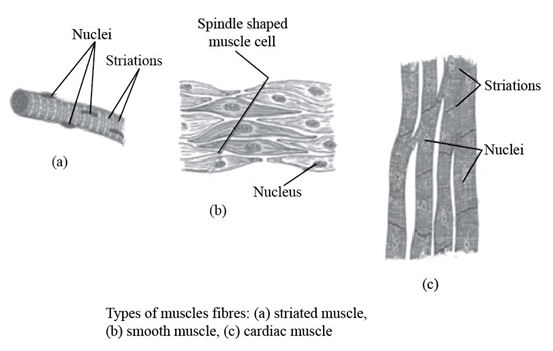Diagrammatically show the difference between the three types of muscle fibres.
The three main types of muscle fibers are striated (or skeletal), smooth, and cardiac. Striated muscle fibers are long, cylindrical, and multinucleated, with a striped appearance due to the arrangement of muscle proteins. Smooth muscle fibers are spindle-shaped, uninucleated, and lack striations. Cardiac muscle fibers are branched, uninucleated, and possess a faint striation pattern, similar to striated muscle, but with intercalated discs connecting them.
Striated (Skeletal) Muscle Fibers:
Shape: Cylindrical, long, and multinucleated.
Nuclei: Multiple nuclei located along the length of the fiber.
Appearance: Striated (striped) due to the arrangement of actin and myosin filaments.
Function: Voluntary movement, posture, and body support.
Smooth Muscle Fibers:
Shape: Spindle-shaped (tapering at both ends).
Nuclei: Single nucleus located in the center of the fiber.
Appearance: Non-striated (lack stripes).
Function: Involuntary movement of internal organs, like the stomach, intestines, and blood vessels.
Cardiac Muscle Fibers:
Shape: Branched, cylindrical, and uninucleated.
Nuclei: Single nucleus located in the center of each fiber.
Appearance: Faintly striated, similar to striated muscle, but with intercalated discs (specialized cell junctions) connecting the fibers.
Function: Pumping of blood by the heart.
